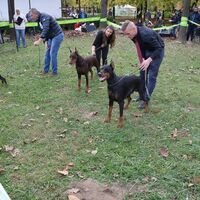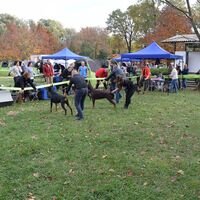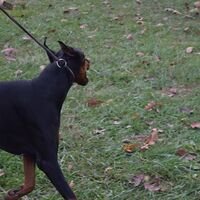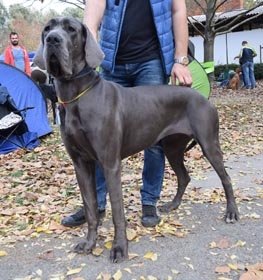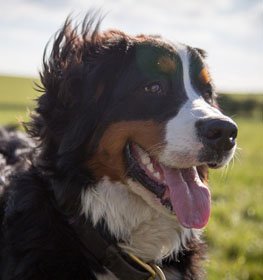Doberman Pinscher Information & Dog Breed Facts
Collection of all the general dog breed info about Doberman Pinscher so you can get to know the breed more.
| Group | Working Dogs |
|---|---|
| Popularity Rank | 16 |
| Reviews | 18 |
| User Ratings | |
|
Compare the Doberman Pinscher With Other Dogs
Select at least one dog breed to make the comparsion. | |
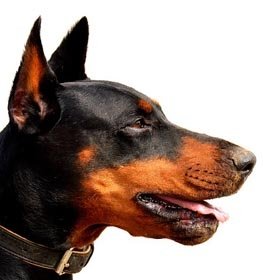 | |
| Origin | |
|
Common Names & Aliases
What other names is a Doberman Pinscher known by? Discover all traditional, regional and informal names used for this breed. | DobermanDobermannDobynmDobie |
|---|---|
|
Breed Classification
What type of dog breed is a Doberman Pinscher? Learn about its genetic classification and breeding category. | Purebred The Doberman Pinscher is considered a purebred dog breed, but many mixes and hybrids have been created from this breed. We have compiled a list of Doberman Mixes. |
Photo Gallery of the Doberman Pinscher Breed
|
Size Classification
What size category is a Doberman Pinscher? Learn how big the Doberman Pinscher breed typically grows. | Medium |
|---|---|
|
Weight Statistics
How much does a Doberman Pinscher weigh? Discover typical weight ranges for adult males and females of the Doberman Pinscher breed. | Male: 88-99 pounds (40-45 kg), Female: 71-77 pounds (32-35 kg) |
|
Average Weight
What is the average weight of a Doberman Pinscher? | Male: 93.5 pounds (42.5 kg), Female: 74 pounds (33.5 kg) |
|
Height
How tall is the Doberman Pinscher? Doberman Pinscher height: | Male: 26-28 inches (66-71cm), Female: 24-26 inches (61-66 cm) |
|
Average Height
What is the average height of a Doberman Pinscher? | Male: 27 inches (68.5 cm), Female: 25 inches (63.5 cm) |
|
Price Range
How much does a Doberman Pinscher puppy cost? Find current market prices and factors affecting Doberman Pinscher costs. | $800-$1000 If you choose to purchase the Doberman Pinscher, you should know that the mentioned amount of money is an average of the collected data from breeders’ sites and puppy finder places. If you have a Doberman Pinscher for sale, please advertise it on a reliable website to make sure the Doberman Pinscher gets to a happy place. |
|---|---|
|
Availability
How easy is it to get a Doberman Pinscher? How many Doberman Pinscher are there in the world? | Very frequent: The Doberman Pinscher is quite easy to get. There is a risk of overbreeding, as it is an extremely popular breed. Inbreeding is common because of its popularity. A new study suggests that inbreeding contributes to the incidence of disease and health problems. So be careful, buy from a trustworthy place or kennel and seek the help of an experienced person, a professional, to make the right decision. |
|
Intelligence Rating
How intelligent is a Doberman Pinscher? Discover the Doberman Pinscher's intelligence ranking and learning capabilities. | Outstanding: Doberman Pinscher is one of the brightest dog breeds. They desire to learn tricks and commands often. The limit is your creativity. They understand and memorize new commands in fewer than 5 repetitions. This breed obeys the first command 95% of the time or better.
The Doberman Pinscher is one of the best breeds in the dog intelligence ranking. |
|---|---|
|
Training Difficulty
How easy is it to train a Doberman Pinscher? Learn about the Doberman Pinscher's trainability and response to training methods. | Doberman Pinscher dogs are quite easy to train. Sometimes they can be challenging, but if you're consistent in teaching new commands they will obey for sure. |
|
Watchdog Rating
How good is a Doberman Pinscher as a watchdog? Learn about the Doberman Pinscher's alertness and guarding instincts. | Doberman Pinscher dogs are one of the best watchdogs. Their main job is to observe and they're very consistent in their effort. The best vocal cords and sense of hearing belong to them. Usually, they're very territorial and protective about their property, so the Doberman Pinscher dogs will alert you if they sense something different. |
|
Territorial Protection
Is a Doberman Pinscher protective of its territory? Learn about the Doberman Pinscher's guarding instincts and behavior. | Doberman Pinscher dogs are extremely protective guard dogs. This breed doesn't hesitate to protect its territory so the Doberman Pinscher can be a good choice if you want an excellent guard dog. Keep calm and the Doberman Pinscher will take care of unwanted people or animals. |
|
Personality Traits
What personality does a Doberman Pinscher have? Learn about characteristic Doberman Pinscher temperament and behavior traits. | EnergeticAlertIntelligentObedientLoyalFearless |
|---|---|
|
Sensitivity Level
How sensitive are they? Doberman Pinscher sensitivity: | Sensitive: Doberman Pinscher dogs don't like an irregular daily routine, noisy household, and frequent guest visits.
This breed's emotional level reflects their owner's feelings and they don't handle punishments well. |
|
Affection Level
How affectionate are they? Is a Doberman Pinscher a good family dog? | High: Doberman Pinscher dogs are genuinely loyal, soft and gentle, loving, and affectionate dogs toward their handlers. They enjoy quality time with their owners despite the activity and are considered great therapy dogs for those in need. This breed responds strongly to their handler's emotions because they bond closely. Their happiness is your happiness. |
|
Social Needs
How much social interaction does the Doberman need? Doberman Pinscher social needs: | Doberman Pinscher dogs need for social interaction is average. This breed likes being around people or other animals, but they don't mind being left alone for a few hours either. |
|
Impulse to Wander or Roam
How likely is the Doberman Pinscher to run away? Does this breed explore or wander a lot? Does Doberman Pinscher roam? | Doberman Pinscher dogs tend to escape less than other breeds. They have low to average wanderlust potential. Exploring the world is not the best activity they can imagine. |
|
Prey Drive
Do this canine have a strong prey drive? Does Doberman Pinscher have high prey drive? | Their prey drive is low. Doberman Pinscher dogs don't have an impulse to catch or chase small animals. |
|
Barking Frequency
Does a Doberman Pinscher bark a lot? Learn about typical Doberman Pinscher vocalization patterns and triggers. | Low to Average: The Doberman Pinscher rarely barks. This breed could be a good choice if you're looking for a quiet breed. They don't bark unless there is a good reason.
Top reasons for barking: protection, alarm, fear, boredom, attention-seeking, greeting, separation anxiety, compulsive barking. |
|---|---|
|
Playful Nature
How playful is a Doberman Pinscher? Understand the typical play drive and energy level of the Doberman Pinscher breed. | Average: Doberman Pinschers, like any other dog breed, like playing. Sometimes they bark in excitement for playing, but they are not the most playful dog breed. |
|
Apartment Adaptability
Can a Doberman Pinscher live in an apartment? Learn about the Doberman Pinscher's suitability for apartment living. | Very house-friendly dog the Doberman Pinscher breed. It's good if you have a small garden where he can go out and do his business, but it's not important at all. You can get enough exercise with one or two walks a day, so keeping them indoors shouldn't be a problem. |
|
Lifestyle Adaptability
How adaptable is a Doberman Pinscher to lifestyle changes? Learn about the Doberman Pinscher's flexibility to new situations. | Doberman Pinscher dogs adapt very well to lifestyle changes and basically all living environments. They don't mind moving from one place to another with their owner. |
|---|---|
|
Alone Time Tolerance
Can a Doberman Pinscher be left alone? Learn about the Doberman Pinscher's tolerance to solitude. | Just like every puppy, they are prone to panic, cry, bark, whine when they left alone by their owner. With proper socialization and quality time with the dog can solve this problem. |
|
Bite Risk Assessment
What is a Doberman Pinscher biting potential? Learn about the Doberman Pinscher's bite risk factors. | Moderate ⏺ The Doberman Pinscher has an average chance of biting somebody. Top reasons for dog bite: protection, pain, excitement, herding instinct, being provoked. (Data based on the available online bite statistics.) |
|---|---|
|
Mouthing Tendency
Is a Doberman Pinscher mouthy? Learn about the Doberman Pinscher's tendency to use mouth during play. | Doberman Pinscher dogs have a lower than average tendency to nip, chew, playbite, or herd people. It's a common habit during puppyhood, not aggressive behavior. These "bites" don't hurt, but Doberman Pinscher dogs need to be taught a good attitude. |
|
Bite Strength Rating
How strong is a Doberman Pinscher bite? Learn about the Doberman Pinscher's bite force measured in PSI. | Between 200 and 400 PSI ⏺ Doberman Pinscher bite force: Ordinary. Bite force Doberman Pinscher measurements typically fall within the range of 200 to 400 PSI. The bite force of a Doberman Pinscher is considered ordinary when compared to other dog breeds, but it is still quite powerful. This Doberman Pinscher bite force PSI can cause bite wounds. Doberman Pinscher bite PSI is not something that should be feared if the dog is well-trained and managed. To avoid any issues, it's essential to learn how to train a Doberman Pinscher puppy not to bite from an early age.
The Doberman Pinscher, and many others, have a fearsome presence because they have significant jaw strength, so it is important not to anger the dog and have it around strangers until it is fully trained. However, they are usually quite calm and good companions, they work well in families and are easy to care for. In conclusion, while the Doberman Pinscher bite force is certainly an interesting aspect of the breed, it is important not to let it overshadow the many other reasons why these dogs are so loved and respected. With proper training and socialization, a Doberman Pinscher can be a loyal and protective companion for your family. |
|
Average Lifespan
How long does a Doberman Pinscher live? Learn about the typical lifespan of the Doberman Pinscher breed. | 10-12 years The average lifespan of Doberman Pinscher: 11 years |
|---|---|
|
Climate Tolerance
How well does a Doberman Pinscher handle different weather? Learn about the Doberman Pinscher's climate adaptability. | Prefers warm weather Dogs that prefer warm weather conditions are typically breeds that were originally bred in warmer climates. |
|
Health Concerns
What health issues are common in a Doberman Pinscher? Discover typical conditions affecting the Doberman Pinscher breed. | Doberman Pinschers are commonly healthy dogs. Vet costs aren't expensive with this breed. |
|
Vet Care Frequency
How often does a Doberman Pinscher need vet visits? Learn about the Doberman Pinscher's veterinary care requirements. | Rare The Doberman Pinscher should have a complete physical check-up at least every 12-18 months (but preferably once per year). If your dog shows any symptoms, call your veterinarian. |
|
Health Problems
What genetic/health problems does the Doberman Pinscher breed have? What are the health issues and concerns of the Doberman Pinscher breed? Most common health risks of Doberman Pinscher: | Hip Dysplasia Progressive retinal atrophy (PRA)Von Willebrand's DiseaseWobbler's SyndromeCardiomyopathy |
|
Energy Rating
How energetic is a Doberman Pinscher? Understand daily activity needs of the Doberman Pinscher breed. | Doberman Pinscher dogs have a higher energy level than other dog breeds. If you want a dog for snuggling on the couch, this breed isn't the perfect choice for you. |
|---|---|
|
Activity Requirement / Exercise Need
How much exercise does a Doberman Pinscher need? How much exercise do Doberman Pinscher dogs require per day?
Do Doberman Pinscher dogs need a lot of exercises? | Doberman Pinscher dogs need quite a lot of exercise. Daily walks should be on schedule. If you live an active life, this breed can be a good choice for you. |
|
Sleeping Need
How much sleep does the Doberman Pinscher breed need? | Doberman Pinscher dogs sleep 12-14 hours a day as an average dog and they're not considered a lazy breed. |
|
Obesity Tendency
Is a Doberman Pinscher prone to weight gain? Learn about the Doberman Pinscher's obesity risks. | Average: The Doberman Pinscher has an average risk for obesity. Daily walks should be on schedule. To make your dog happy and fit, feed him with quality dry dog food and live an active life together. Try to find the happy medium between exercise and feeding.
If you notice any weight gain, consult your veterinarian and make a diet plan. Reduce unhealthy food and snacks, and measure the Doberman Pinscher weight regularly. |
|---|---|
|
Food Consumption
How much food does a Doberman Pinscher need daily? Learn about the Doberman Pinscher's feeding requirements. | 5 to 6 cups of high-quality dry food a day, divided into two meals. |
|
Allergy Friendliness
Is a Doberman Pinscher hypoallergenic? Learn about the Doberman Pinscher's suitability for allergy sufferers. | No Doberman Pinscher dogs don't do well with allergy sufferers by causing allergic reactions. Some dog breeds are even considered to higher possibility of an allergic response. Coat type isn't necessarily relevant, because most people are allergic to dander (flakes on the dog's skin) or saliva, not actually to dog hair. |
|---|---|
|
Coat Colors
What colors does a Doberman Pinscher come in? Discover all possible Doberman Pinscher color variations. | BlackTan Red Blue White Brown |
|
Grooming Requirements
How much grooming does a Doberman Pinscher need? Learn about Doberman Pinscher coat maintenance requirements. | Easy to groom: The Doberman Pinscher doesn't require a lot of grooming. Seasonal flea treatment is needed, but cutting the dog's hair by a professional groomer isn't necessary. Ears and eyes should be cleaned regularly to avoid infections. Doberman Pinscher is a good choice if you don't have the time, skill, or money to take care of a high-maintenance dog. Recommended for beginners. |
|
Drooling Tendency
Does a Doberman Pinscher drool a lot? Learn about the Doberman Pinscher's drooling habits. | The Doberman Pinscher drools quite a lot, so if you dislike being covered by slobber spots on your clothes, you may want to choose another dog breed. Drooling is the unintentional saliva flowing outside of the mouth. It can be completely normal or a sign of a health problem. Certain dog breeds drool more than others, just like the Doberman Pinscher.
If you notice any change in your dog's drooling habit, you should contact a vet as soon as possible. |
|
Stinkiness Rating
Does a Doberman Pinscher smell bad? Learn about the Doberman Pinscher's natural odor levels. | Medium ⏺ The Doberman Pinscher has an average chance of bad smell. Top reasons for dog stinkiness: infection of bad tooth/ear/skin folds, gas attacks. |
|
Coat Characteristics
What type of coat does a Doberman Pinscher have? Learn about the Doberman Pinscher's fur characteristics. | Fine |
|
Bathing Needs
How often does a Doberman Pinscher need baths? Learn about the Doberman Pinscher's bathing requirements. | 3-4 weeks More often than average. These dog coats tend to be longer, softer, and oilier than short-haired breeds. While a good bath every now and then is a great way to keep your buddy from becoming overly smelly, be mindful about overbathing.
Bathing will wash away your dog’s natural oils, while a simple brushing every few days should keep them clean. |
|
Shedding Level
How much do Doberman Pinscher dogs shed? How to control, reduce and prevent the shedding of the Doberman? Do Doberman Pinscher dogs shed a lot? | Doberman Pinscher dogs shed moderately. It's a natural process of the hair growth cycle. Regular brushing reduces the amount of hair that sheds. It mostly depends on their health status and breed type. |
|
Child Compatibility
Is a Doberman Pinscher good with children? Learn about the Doberman Pinscher's behavior around kids of different ages. | Doberman Pinscher dogs are average friendly dogs towards children. |
|---|---|
|
Pet Compatibility
How well does a Doberman Pinscher get along with other pets? Discover the Doberman Pinscher's compatibility with other animals. | Doberman Pinscher dogs are generally with other pets. |
|
Stranger Friendly
Are they aggressive or friendly towards/with strangers? Doberman Pinscher temperament with other people: | Doberman Pinscher dogs are not stranger friendly dogs. |
|
Cat Friendly
How well do Doberman Pinscher dogs get along with cats? Are they good with kittens? What is this fido's temperament with cats? Can they be good with cats? Can the Doberman Pinscher breed live with a cat? | Doberman Pinscher dogs are average friendly towards cats. |
|
Dog Friendly
Is Doberman Pinscher good with other dogs? Are they dog-friendly dogs? How well do Doberman Pinscher dogs get along with other dogs? | Doberman Pinscher dogs are not the most dog-friendly dogs. If you want more dogs in your family or you'd like to join dog meetups, the Doberman Pinscher is not a good choice. |
|
Good For First Time Owners
Is Doberman Pinscher breed good for first-time owners? Do they make a good dog for novice owners? Is Doberman Pinscher breed suitable for first-time owners? | Yes Doberman Pinscher dogs are good for novice owners, due to their easy-going personality. |
|
Office Friendly
Are Doberman Pinscher dogs good office canines? Do Doberman Pinscher dogs make good office-friendly pets? Can they be office dogs? | No Doberman Pinscher is not the best dog breed for office environment. |
|
Senior Citizens Friendly
Are they senior citizens friendly dogs? How well do Doberman Pinscher dogs get along with the elderly people? What is the Doberman temperament with senior people? Are Doberman Pinscher dogs good for elderly owners? | Doberman Pinschers are commonly okay with elderly people. |
|
Service Dog Capability
Can a Doberman Pinscher be a service dog? Learn about the Doberman Pinscher's service work potential. | Not really This breed generally not used as a service dog. A service dog is a term used in the USA to refer to any type of assistance dog specifically trained to help people who have disabilities, such as visual impairment, hearing impairments, mental disorders, seizures, mobility impairment, and diabetes. Service dogs are protected under the ADA (Americans with Disabilities Act).
Doberman Pinscher is not the best breed for service purposes. |
|---|---|
|
Therapy Work Suitability
Is a Doberman Pinscher good as a therapy dog? Learn about the Doberman Pinscher's therapy work aptitude. | Not really This breed is generally not used as a therapy dog. A therapy dog is a dog that might be trained to provide affection, comfort, and love to people in hospitals, retirement homes, nursing homes, schools, hospices, disaster areas, and people with anxiety disorders or autism.
Doberman Pinscher is not the best breed for therapeutic purposes. |
|
Scent Detection Ability
Is a Doberman Pinscher good at detection work? Learn about the Doberman Pinscher's scenting abilities. | Not really They are not typically employed for this type of work, but there may be exceptional cases. A detection dog or sniffer dog is a dog that is trained to use its senses (mostly its smell) to detect substances such as explosives, illegal drugs, wildlife scat, currency, blood, and contraband electronics such as illicit mobile phones.
Doberman Pinscher is not the best breed for detection purposes. |
|
Search & Rescue Potential
Can a Doberman Pinscher do search and rescue? Learn about the Doberman Pinscher's SAR capabilities. | Not really This dog breed is not typically used as a search and rescue dog. The use of dogs in search and rescue (SAR) is a valuable component in wilderness tracking, natural disasters, mass casualty events, and locating missing people.
The Doberman Pinscher is not the best breed for SAR purposes. |
|
Maritime Work Ability
Is a Doberman Pinscher good on boats? Learn about the Doberman Pinscher's maritime capabilities. | Not really Doberman Pinscher breed usually doesn't like being on a boat. Boat dogs were typically bred for their strength, stamina, and water resistance, as they were often required to perform tasks such as pulling in fishing nets, and jumping into the water to retrieve ropes or lines, or helping to move cargo. Sailor dog is a type of dog that was bred to accompany sailors on their voyages. They were typically used for three purposes: as a working dog, a watchdog, and as a companion. A boat dog is a term used to describe a type of dog that was traditionally bred and used as a working dog on boats. |
|
Draft Work Capability
Can a Doberman Pinscher pull carts? Learn about the Doberman Pinscher's drafting abilities. | Not really A drafting dog or draft dog is a dog bred and used for cart pulling. Dogs bred for this work have strong builds and qualities that are needed, strength and determination.
Doberman Pinscher is not the best breed for drafting purposes. |
|
Military Service Background
Was a Doberman Pinscher used in military service? Learn about the Doberman Pinscher's military history. | Yes In history, this breed was unfortunately used for combat dogs. A combat dog is a specially trained dog that is used in warfare to help protect military personnel and assets. Combat dogs are often deployed in areas where there is potential for contact with the enemy, such as during raids or search operations.
Combat dogs are typically assigned to either infantry or special operations units. They are used for a variety of tasks including area security, sentry duty, trackers, and explosive detection. In addition to their combat roles, combat dogs also play an important role in troop morale by providing companionship and emotional support. |
|
Puppy Litter Size
How many puppies does a Doberman Pinscher usually have? Learn about typical litter sizes. | 6-10 puppies |
|---|---|
|
Pregnancy Duration
How long is a Doberman Pinscher pregnant? Learn about the Doberman Pinscher's gestation period. | 60-64 days Reproductive cycle of the female Doberman Pinscher: The first period called Proestrus lasts for about 9 days.
During this time the females start to attract males. You can notice by swelling vulva and bloody discharge. The second part is the Estrus when the female is receptive for the male. It lasts for about 3 to 11 days. The sign of the proestrus part is the soft and enlarged vulva. The discharge decreases and lightens in color. The third part is the Diestrus. Normally, it occurs around day 14. In this period the female’s discharge changes for vivid red and coming to its end. The vulva returns to average, and she will no longer permit mating. The fourth part called the Anestrus. The time frame between heat periods normally lasts about six months. |
|
Breeding Frequency
How often can a Doberman Pinscher have puppies? Learn about safe breeding intervals. | Once a year. More frequent breeding is not healthy. It is very important not to buy a dog from a puppy mill, where the needs of the pups and their mothers are ignored. It's an inhumane high-volume dog breeding facility, where puppies born several times a year. |
|
AKC Classification
What AKC group is a Doberman Pinscher in? Learn about the Doberman Pinscher's AKC classification. | Recognized by the American Kennel Club in 1908 as a Working breed. |
|---|---|
|
FCI Classification
What FCI group is a Doberman Pinscher in? Learn about the Doberman Pinscher's international classification. | Recognized by FCI in the Pinscher and Schnauzer - Molossoid and Swiss Mountain and Cattledogs group, in the Pinscher and Schnauzer type section. |
|
Kennel Club Recognition
Which kennel clubs recognize a Doberman Pinscher? Learn about the Doberman Pinscher's official recognition. | American Canine RegistryAmerican Kennel ClubAmerica's Pet RegistryCanadian Kennel ClubDog Registry of America Inc.Federation Cynologique InternationaleKennel Club of Great BritainNorth American Purebred Registry, Inc.American Canine Association, Inc.Australian National Kennel CouncilContinental Kennel ClubNew Zealand Kennel ClubUnited Kennel ClubCanadian Canine Registry |
Doberman Pinscher Pros and Cons
- Intelligence Rating: Outstanding: Doberman Pinscher is one of the brightest dog breeds.
- Health Concerns: Doberman Pinschers are commonly healthy dogs.
- Apartment Adaptability: Very house-friendly dog the Doberman Pinscher breed.
- Grooming Requirements: Easy to groom: The Doberman Pinscher doesn't require a lot of grooming.
- Watchdog Rating: Doberman Pinscher dogs are one of the best watchdogs.
- Mouthing Tendency: Doberman Pinscher dogs have a lower than average tendency to nip, chew, playbite, or herd people.
- Impulse to Wander or Roam: Doberman Pinscher dogs tend to escape less than other breeds.
- Lifestyle Adaptability: Doberman Pinscher dogs adapt very well to lifestyle changes and basically all living environments.
- Good For First Time Owners: Doberman Pinscher dogs are good for novice owners, due to their easy-going personality.
- Allergy Friendliness: Doberman Pinscher dogs don't do well with allergy sufferers by causing allergic reactions.
- Drooling Tendency: The Doberman Pinscher drools quite a lot, so if you dislike being covered by slobber spots on your clothes, you may want to choose another dog breed.
- Dog Friendly: Doberman Pinscher dogs are not the most dog-friendly dogs.
- Office Friendly: Doberman Pinscher is not the best dog breed for office environment.
Doberman Pinscher History
Doberman Pinscher Origin
The Doberman Pinscher is a relatively modern breed, having been developed in Germany in the 1890s. A man called Karl Friedrich Louis Doberman worked in a number of high-risk jobs, including tax collection and night policing. It was normal practice at the time for members of these professions to have protection dogs with them to scare attackers or defend themselves if required. For some unknown reasons, Doberman was dissatisfied with the breeds and mixed that was already in use for this purpose, so he chose to make his own breed. The exact date when Doberman began to create his own dog is known, but it is generally accepted that he probably initiated casual breeding efforts in the 1870s or 80s and that the real birth year of the Doberman Pinscher occurred in 1890 when he purchased a house in Apolda with the intention of becoming a serious breeder. He was seeking the ideal personal protection dog, one that was intelligent, loyal, and fearless, as well as possessing a natural protective instinct and a trustworthy personality. However, Mr. Dobermann did not keep detailed records of the dogs he used, and in many cases the breeds of the dogs he used to make his personal security dogs were unknown.
Debates concerning the basis for the breed
The main point of contention among modern fanciers is which breed was used to create the Doberman. Some say it was a German Pinscher, which was one of the most popular German breeds at the time and looked very similar to a Doberman Pinscher. Others argue that it was the Old German Shepherd, the ancestor of the modern German Shepherd dog. Others have speculated that it was the Beauceron, a French dog that was transported to Germany by Napoleon’s army and is strikingly similar to the Doberman Pinscher in many ways. The truth is that Mr. Doberman employed so many breeds that no single one predominates, and the majority of early Doberman lines were most likely mixed and stray dogs. In addition to the German Pinscher, Old German Shepherd, Beauceron, and mixed breeds, the Rottweiler, Bullenbeiser, and Weimaraner were almost certainly used as well. Other possibilities which have been suggested by experts include the Boxer, the English Bulldog, the Staffordshire Bull Terrier, and various types of German scent hound.
The breed’s job
Whatever breeds went into the ancestry of the Doberman Pinscher, the breed standardized very quickly. By the time of Mr. Doberman’s death in 1894, the breed was largely stabilized. Since their inception, these dogs have served as guard dogs, police dogs, and military dogs, and they were also major actors in World War II, functioning as sentries, couriers, and even scouts. Dobermans were involved indirectly supporting the military in the battle of Okinawa in 1945, and a memorial statue of a Doberman stands in Guam to commemorate the 25 marine war dogs that gave their lives to free it. However, these brave dogs have a gentler side, they can make loving and affectionate companions, as well as true and loyal friends to those they care about.
Doberman Pinscher Recognition
Although it is not quite clear when the first Doberman arrived in the United States, among the first of which we have records were imported in 1907. In 1908, the American Kennel Club granted full recognition to the Doberman Pinscher as a member of the Working Group. By 1921, interest in the breed has increased to the point that George Earle III founded the Doberman Pinscher Club of America to promote and protect the breed in the country. Throughout the 1920s, interest further increased in the breed, likely the result of the World War I veterans wanting a guard dog to protect their newly brought properties. Moreover, beginning in the 1940s, the United Kennel Club also granted full recognition to the breed.
Latest Doberman Pinscher Compares
Doberman Pinscher Names
How old is my Doberman Pinscher in human years?
You May Also Like
Rate The Doberman Pinscher Breed
Doberman Pinscher Comments, Reviews and Questions
- HELLO TOO BIG
Jun 12, 2024, 2:26:18 AM:
I'm fat and stupid
- dog fan
Jun 11, 2024, 12:25:32 AM:
great dog more friendly than you think
- Kathleen
Jan 24, 2024, 9:25:51 AM:
Dobies make GREAT SERVICE DOGS! A doberman will KEEP LEARNING new tasks it's whole "working life". People have pegged them to be dangerous. TV helped. EMTs won't assist. I'll still put my life in the hands of a dobie.
- Luka Videos
Mar 8, 2023, 8:59:51 AM:
I love dobermans
- Jake Kazazian
Apr 23, 2022, 2:12:29 PM:
I have 2 dobies and a boxer. I don't neccessarily agree with the dobermans being one star for stranger friendly, and two stars for dog friendly.
- Jake Kazazian
Apr 23, 2022, 2:12:11 PM:
My dobes are both very good with strangers and dogs. Maybe not outgoing, but they're aren't "not stranger/dog friendly" Otherwise, I feel like the numbers reflect my dogs pretty well.
- Nia
Feb 25, 2022, 6:51:07 AM:
- Odion Fisch
Jan 8, 2022, 1:42:01 AM:
My newest Dobie (A puppy, and one of six) learned off leash training in two days, potty training in six hours, and crate training in an hour and a half. BTW this is only at 8 months!!!
- Odion Fisch
Jan 8, 2022, 1:38:20 AM:
Luckily, Dobermans are very intelligent, and they adapt and learn from your training and lifestyle very quickly. So if you stay consistent with socialization, Doberman's are great for whatever role you want them in.
- Odion Fisch
Jan 8, 2022, 1:35:47 AM:
A Dobermans natural instinct is to be loyal and loving to their owners, they are great family dogs. Dobermans are some of the most versatile breeds when it comes to dogs, so if you DO want a guard dog, then the Doberman will suit your needs.
- Odion Fisch
Jan 8, 2022, 1:32:24 AM:
Listen, to everybody having doubts about Dobermans, you should really read this. First of all, Dobermans are wrongly stereotyped as vicious dogs. But the reason they are this way is because people trained them to be that way.
- Jennifer Morningstarr
Aug 2, 2021, 9:42:20 AM:
Best dogs ever. Good with cats of the household, friendly , loyal , loving. Prefers large garden but will also adapt to apartment life. Important thing loving connection with owner.
- DobieMom
Jul 20, 2021, 12:20:31 PM:
Mine is comical, loving, goofy, sometimes stubborn, always by my side and overall a fantastic pet. He does have allergies but is otherwise very healthy at 9 years old. He loves everyone he meets.
- Max
Jun 1, 2021, 8:14:33 AM:
Shut up hello too big idiot
- dumb hello too big idiot
Jun 1, 2021, 6:51:31 AM:
I like your advice of a Doberman and it is really good facts to know about
- Nathan
Dec 27, 2020, 3:21:09 AM:
dog being to big isn't a reason to not get it also a dangerous dog isnt a breed it's a owner who takes care of it PERIOD.
- HELLO TOO BIG
Nov 23, 2020, 8:43:28 PM:
This dog breed is very dangerous. DON'T GET IT!!!
- Buddy
May 7, 2020, 9:28:50 AM:
V.v good



